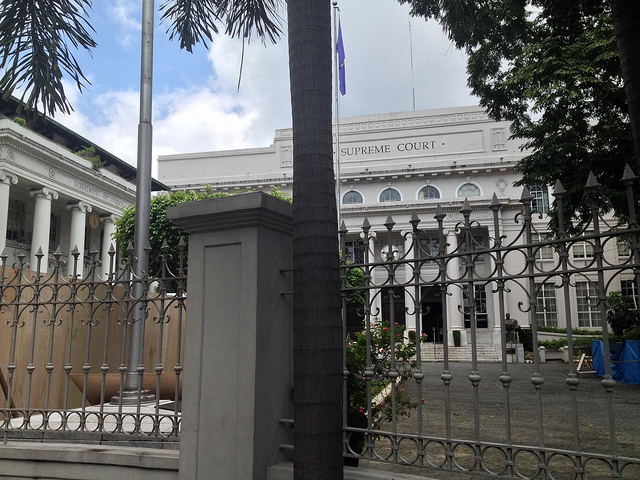On January 12 the Philippine Supreme Court came out with a courageous decision reaffirming the constitutionality of the 2014 Enhanced Defense Cooperation Agreement (EDCA) between the Philippines and the United States. In a 10 to 4 decision, the Supreme Court upheld the EDCA, paving way for the return of forward-deployed U.S. forces to select Philippine military bases.
This comes more than two decades after U.S. troops left the country in 1992 following the Philippine Senate’s non-concurrence with the Philippine-American Cooperation Treaty of 1991, which would have allowed for the continued stay of two major U.S. military facilities—Clark Air Base and Subic Naval Base. The 10-year EDCA is considered a calculated effort by Manila and Washington to make the Philippines again a major staging base for projecting U.S. naval and air power in the face of China’s maritime expansion in the South China Sea.
Defense Secretary Voltaire Gazmin and U.S. ambassador to the Philippines Philip Goldberg signed the EDCA on April 28, 2014, a few hours before President Barack Obama arrived in Manila for his first state visit. The EDCA is not a new agreement since it merely updates and enhances the 1951 Mutual Defense Treaty. The EDCA allows U.S. forces to utilize facilities owned and controlled by the Armed Forces of the Philippines, but ensures that the Philippine base commander retains unhampered access to those locations. Likewise, the U.S. military will be able to build or improve the infrastructure inside these installations, but Philippine forces will be able to jointly use them. Furthermore, any construction and other activities within Philippine bases requires the consent of the Philippine-U.S. Mutual Defense Board and Security Engagement Board.
Left-wing groups and two retired Philippine senators held up the approval of the EDCA, questioning its constitutionality by arguing that it is not an executive agreement but rather a treaty requiring approval from the Philippine Senate. In November 2015, the Philippine Senate passed a resolution asking the Supreme Court to compel the executive branch to submit the agreement to the upper chamber in the form of a treaty requiring concurrence by at least two thirds of senators. The Senate’s position paper on the agreement was submitted to the Supreme Court during its deliberations on the EDCA in late 2015.
These legal issues raised by political activists and retired and current senators pushed the EDCA into a legal limbo. For almost two years, the Philippine and U.S. governments waited in vain for a decision from the Philippine Supreme Court before the agreement could be implemented. The high court even postponed deliberations three times between November and December 2015 before finally issuing its ruling in early January.
The Supreme Court upheld the executive branch’s position that the EDCA is an implementing agreement of the 1999 Visiting Forces Agreement (VFA) and the 1951 Mutual Defense Treaty, which already provided for the rotational and temporary presence of U.S. forces in the Philippines. The high court noted that as an executive agreement, the EDCA is consistent with the existing Philippine laws and treaties that it seeks to implement, and with the 1987 Constitution which authorizes the chief executive to enter into an executive agreement on foreign military bases, troops, or facilities that “merely aims to implement an existing law or treaty.” The court declared that the EDCA as a form of executive agreement, is solely within the powers of the president, and does not require Senate concurrence. The Supreme Court ruling emphasized that that “EDCA is not the instrument that allows U.S. troops or facilities to enter (the Philippines) as the VFA has already done that.”
Beyond Constitutional Reaffirmation
The high court’s deliberations on the EDCA occurred in the face of China’s continuing building of artificial islands in the South China Sea. The court’s decision thus reflects the Philippines’ concern over Chinese island-building activities in the Spratlys, and the urgency of granting the Philippine executive certain leeway in foreign and defense affairs. The Supreme Court ruled that “the President must be accorded wider discretion in making decisions regarding external affairs, limited only by the letter of the law.” The decision emphatically stated that “no court can tell the President to desist from choosing an executive agreement over a treaty to embody an international agreement,” unless clearly disallowed by the constitution.
Once the EDCA is implemented, a small contingent of U.S. forces will be deployed in Philippine territory temporarily and on a rotational basis. This will probably include the stationing of a squadron of U.S. Marine fighter planes in a Philippine Air Force base for six months. This squadron will likely be replaced by a U.S. Navy fighter-bomber squadron that will be stationed in another Philippine Air Force or Navy base for six months. U.S. forces will be stationed in the country through two types of access arrangements:
- Forward operating sites—expandable, partially equipped facilities with a limited U.S. military support presence.
- Cooperative security locations—facilities maintained by the Philippines with little or no constant U.S. presence. These are less expensive, less visible, and less vulnerable, offering greater strategic and operational flexibility. They are less likely to create local political problems.
A temporary U.S. military presence will strengthen the Philippines’ resolve to uphold its territorial and maritime claims in the South China Sea. By increasing the United States’ ability to respond to crises in the South China Sea, the EDCA could also test American credibility regarding its defense commitment to the Philippines. Though the maritime row in the South China Sea will be a long-term security challenge and will never be solved solely through force, the potential for an armed conflict requires the presence of an effective U.S. deterrent force in the region. The EDCA is aimed at producing such a deterrence posture.
